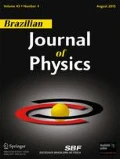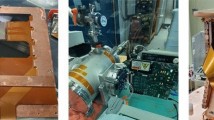Abstract
The calorimeters which will operate in experiments at the hadronic Future Circular Collider—FCC-hh—will be one of the key pieces for the complete exploration of collisions between hadrons. This is because the increasing of energy in proton collisions will require detectors that can work in environments under severe radiation, with high-energy rates, presenting a high resolution and low granularity. In this context, the choice of the hadronic calorimeter of the FCC-hh, the Hadronic Barrel (HB) and the extended barrel (HEB), will be inspired by the ATLAS Tile Calorimeter (TileCal). The HB will have 10 layers, with scintillating tiles that will be separated through a reflective material (e.g., Tyvek) and read by wavelength shifting fibers (WLS) of 1 mm in diameter connected to silicon photomultipliers (SiPMs). Our study focuses on the comparison of the luminous signal intensity in the tile in the first layer of the HB and the tile in the last layer of HB, taking into account the dimensions of the tile. A study on the optimization of the signal uniformity was made, by adding a light-absorbing black strip to the tile, and results were compared with similar experiments performed at CERN. The procedure was performed in the Tilemeter, in the Laboratory of Optics and Scintillating Materials (LOMaC) of the Laboratory of Instrumentation and Experimental Particle Physics, in Lisboa.











Similar content being viewed by others
Notes
Although simplification is adequate for most cases, some situations involve more complex decay. In these cases, representation by means of an exponential of two components is necessary.
References
L.R. William, Techniques for Nuclear and Particle Physics Experiments, Springer. (1994)
A.M. Moraes, A Fsica dos Detectores de Partculas, X Escola do Centro Brasileiro de Pesquisas Fsicas CBPF, Notas de aula, Rio de Janeiro. (2015)
D. Scrates, Instituto de Fsica da Universidade de o Paulo - USP
IST, Detectores de partcula e radiao, Instituto Superior Tcnico, Lisboa
ATLAS Collaboration, the ATLAS detector. J Instrum. 3(8) (2008)
INIS,Captulo 6: Detectores de radiao, International Nuclear Information System INIS
FCC - COLLABORATION, Future Circular Collider Study, Volume 3: The Hadron Collider (FCC-hh) Conceptual Design Report, preprint edited by M. Benedikt et al. CERN accelerator reports, CERN-ACC-2018-0058, Eur. Phys. J. ST, 3, (2018)
R. Patra, et al., Measurement of basic characteristics and gain uniformity of a triple GEM detector, Nucl. Inst. & Meth. A (2017)
A.N. Otte, D. Garcia, T. Nguyen, D. Purushotham, Characterization of Three High Efficiency and Blue Sensitive Silicon Photomultipliers, Nuclear Inst. and Methods in Physics Research A, no prelo, (2016)
R. Marco, Characterization of SiPM: temperature dependencies, Conference Paper in IEEE Nuclear Science Symposium conference record. Nuclear Science Symposium, (2008)
Acknowledgements
We would like to thank the University of Lisbon, Faculdade de Ciências and Instituto Superior Tcnico, LIP and CERN for the support to our project, as well as the Erasmus\(+\)traineeship program for making the participation of the spanish student Iván Panadero possible. Many thanks also go to Louie Larsen for taking part in this work with us. Our gratefulness goes to Joo Gentil, Ricardo Gonçalo and Agostinho Gomes for the relentless supervision given throughout the whole project and all the corrections and help provided. This paper is a continuation of part of their work and would not be possible without them and their experiments.
Author information
Authors and Affiliations
Corresponding author
Additional information
Publisher’s Note
Springer Nature remains neutral with regard to jurisdictional claims in published maps and institutional affiliations.
Rights and permissions
About this article
Cite this article
Machado, R., Panadero, I., Miranda, H. et al. Plastic Scintillators and WLS Optical Fibers in Particle Physics - Characterization of Scintillators for the Future Circular Collider as a Function of Their Dimensions and Aging of WLS Optical Fibers. Braz J Phys 51, 831–839 (2021). https://doi.org/10.1007/s13538-021-00870-2
Received:
Accepted:
Published:
Issue Date:
DOI: https://doi.org/10.1007/s13538-021-00870-2




